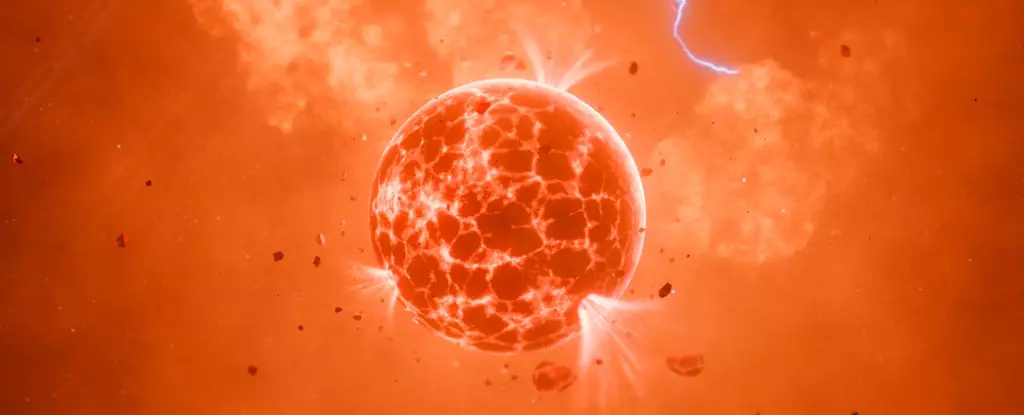In the vastness of our universe, the search for extraterrestrial celestial bodies often yields unexpected findings. A striking revelation has surfaced from astronomers studying a neighboring star system, located a mere 635 light-years away. This star system, centered around a yellow dwarf star named WASP-49, is home to an exoplanet designated as WASP-49b. Recent research has unveiled evidence suggesting the presence of a highly volcanic exomoon orbiting this gas giant, presenting vital information about the dynamics of planetary systems beyond our own.
The cornerstone of this revelation lies in observing a substantial cloud of sodium, believed to be a direct indication of vigorous volcanic activity, surrounding WASP-49b. Notably, the characteristics of the sodium cloud mark it as distinct from any atmospheric attributes of the gas giant itself. This peculiarity raises intriguing questions about the origins of the sodium emission, and challenges prior assumptions about satellite systems in exoplanetary contexts.
Astrophysicist Apurva Oza, a key figure in this research, points out that the sodium cloud’s unique motion suggests it is likely not just part of WASP-49b’s atmosphere. Instead, its trajectory deviates from what would normally be expected of a planetary atmosphere, hinting at an external force, most plausibly an ordinary exomoon. Oza’s statement fortifies the concept that moons could thrive in various forms throughout the Milky Way, fostering a diversity that has been challenging to identify due to the difficulty of detecting such small celestial bodies compared to their larger planetary counterparts.
Traditional observations of moons within our Solar System reveal a staggering count, with nearly 300 known satellites orbiting only eight planets. This overwhelming number creates expectations that similar patterns exist in other star systems. However, the astronomical community faces significant hurdles when attempting to find and confirm exomoons, often managing only to detect signals that could be better explained by alternate celestial phenomena.
The journey toward understanding WASP-49b has progressed through various significant milestones. Back in 2017, astronomers first noted the sodium layer enveloping the exoplanet. This layer resided unnaturally high within the planetary atmosphere, sparking curiosity about its origins. Fast forward two years; emerging research led by Oza began to establish a compelling case for associating the sodium cloud with a volcanic exomoon, similar in characteristics to Io, one of Jupiter’s most intriguing moons.
While the existence of volcanic exoplanets has previously been acknowledged, these objects often exhibit distinct traits such as eccentric orbits and specific thermal signatures attributable to their geological processes. Observations acknowledged that gas giants like WASP-49b should not possess volcanism. Yet, the sodium presence posed an anomaly that warranted further investigation, leading researchers to rule out geological activity from within the planet itself.
Utilizing the European Southern Observatory’s Very Large Telescope, Oza and his team conducted an in-depth analysis of the WASP-49 system over several nights. They confirmed the mass and size of the exoplanet, revealing it to be approximately 0.37 times the mass and 1.1 times the radius of Jupiter, with it completing an orbit of its star roughly every 2.8 days. However, the sodium cloud did not exhibit a steady presence but rather appeared intermittently, which added another layer of intrigue to the study.
Determining the elemental composition and behavior of the sodium detected involved complex modeling. The researchers deduced that the sodium emitted originates from a source undergoing continual volcanic activity due to gravitational influences from WASP-49b. The exomoon’s orbit, projected to be around eight hours, assists in explaining the sodium cloud’s sporadic appearance, which is intertwined with complex gravitational dynamics reminiscent of Io’s relationship with Jupiter.
The implications of this study extend beyond merely identifying a possible volcanic exomoon. If validated, this moon’s fate appears dire. As it orbits closely to WASP-49b, continuous volcanic activity combined with gravitational forces may lead to a decaying orbit. This degradation suggests a potential catastrophic conclusion for the exomoon, predicting a dramatic finale akin to a comet falling into its respective star.
Oza’s research marks an important contribution to the understanding of exomoons and their interactions within complex celestial systems. While the journey is fraught with uncertainties, the continuing exploration in this field could illuminate the intricacies of moon formation and sustain our imagination about the cosmic ballet occurring far beyond the confines of our Solar System. This research not only opens new avenues for understanding the universe but also paints a vivid picture of the dynamic and often violent nature of celestial bodies.


Leave a Reply